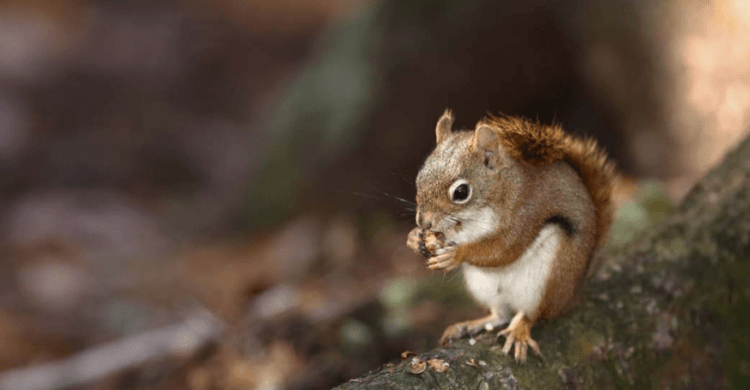The scampering of tiny feet across the base of my sleeping bag was my first clue. My friend’s grumbling was my second. We had paddled miles of the greater Allagash Wilderness along the West Branch of the Penobscot River in northern Maine and had pulled ashore at Big Island to grab much needed rest under the stars. Lacking an alarm, the small residents of the campground had decided to help us out by running across our feet, chests and heads in their search for food at daybreak.
A cracked eyelid revealed the rising sun and pines, along with some of the campground’s permanent and boldest residents, Red Squirrels. These little guys had become acclimated to the wilderness paddlers and kayakers and had over time, grown so bold, they would literally walk all over us in search of any camp food they could pilfer!
The Red Squirrel, Tamiasciurus hudsonicus, is a familiar forest resident to many from Alaska southward through Canada, and down through the Rocky Mountains in the west and along the Eastern Seaboard through the mountains of Georgia. Thriving in pine and mixed canopy forests with abundant fungi, these small tree squirrels fulfill unique ecological roles.
Also known as Pine Squirrels or Chickarees, they are only slightly larger than chipmunks — averaging just 12 inches in length (half of which is tail) and just over 7 ounces in weight. With a cream-colored underside, rich redbrown fur on the flanks, back and head and a white fur eyering, these arboreal rodents are especially attractive and hard-to-miss mammals.
Known for their disproportionately loud calls, Red Squirrels utilize their vocalizations to enforce their territory and announce the presence of predators. As competitors for fluctuating food sources, Red Squirrels establish and defend territories against others of their species. Scientists believe these mammals possess the remarkable ability to differentiate among predators and warn their young of the approach of predators, with higher-pitched alarm calls indicating aerial predators such as hawks and falcons, and lower-pitched alarm calls indicating terrestrial predators such as coyotes and bobcats!
When it comes to obtaining calorie-laden food in the brutal cold of a New England winter, these mammals are as resourceful as they are eye-catching. After gnawing through the bark of Maple trees, Red Squirrels wait for the water to evaporate from the sap and return to consume the vital, energy Maple syrup which remains.
As non-hibernators with a preference for spruce and pine nuts, Red Squirrels will cache or store food in “pantries” both in tress and on the ground. With keen senses of sight, hearing, and especially smell, Red Squirrels cache food in potentially hundreds of pantries throughout their territory. Whether the squirrels simply forget the location of numerous pantries or do not have the ability to retrieve them, the net effect is that they reseed the forests they inhabit. While this is small consolation to the timber companies who witness the damage the squirrels inflict in gnawing trees to obtain sap, Red Squirrels confer other tremendous benefits to the environment.
With their preferred food being highly nutritious pine nuts and fungi, these diurnal mammals spend up to 80% of their day searching for food to eat and store for lean times ahead. They will also eat and store berries, seeds, flowers, bird eggs and occasionally small mammals such as mice. Known for their clever nature, Red Squirrels frequently shake nuts before they expend additional energy gnawing them open. If the nut is desiccated, the squirrel will know it is less nutritious and discard it. Similarly, these small arboreal wonders will harvest fungi and spread them out on tree limbs to dry in the sun before placing them in pantries so that they don’t spoil for winter storage!
With their astounding reversible ankle joints and unparalleled climbing ability, these arboreal wonders access and eat the emerging buds and blossoms high above the forest floor, promoting greater growth among tree canopies and accordingly more cover, shelter and nesting habitat for birds. Perhaps the greatest benefit the squirrel confers is the dispersal of seeds and fungal spores through eating and caching. Some ecologists credit the Red Squirrel as a mammalian “Johnny Appleseed”, unwittingly germinating saplings through the sprouting of their pantry items and delivering nutrients to growing trees through introducing beneficial fungi to their root systems.
Whether aesthetic or ecological, it is often the smallest creatures which deliver the biggest benefits. Whether hiking the trails of the Greenwich Audubon Center, or gazing out on your backyard, keep an eye out for the little Red Squirrel — a true mover and shaker in New England’s forests.
Jim Knox serves as the Curator of Education for Connecticut’s Beardsley Zoo. A Member of The Explorers Club, Jim enjoys sharing his passion for wildlife conservation with audiences in Connecticut and beyond.





